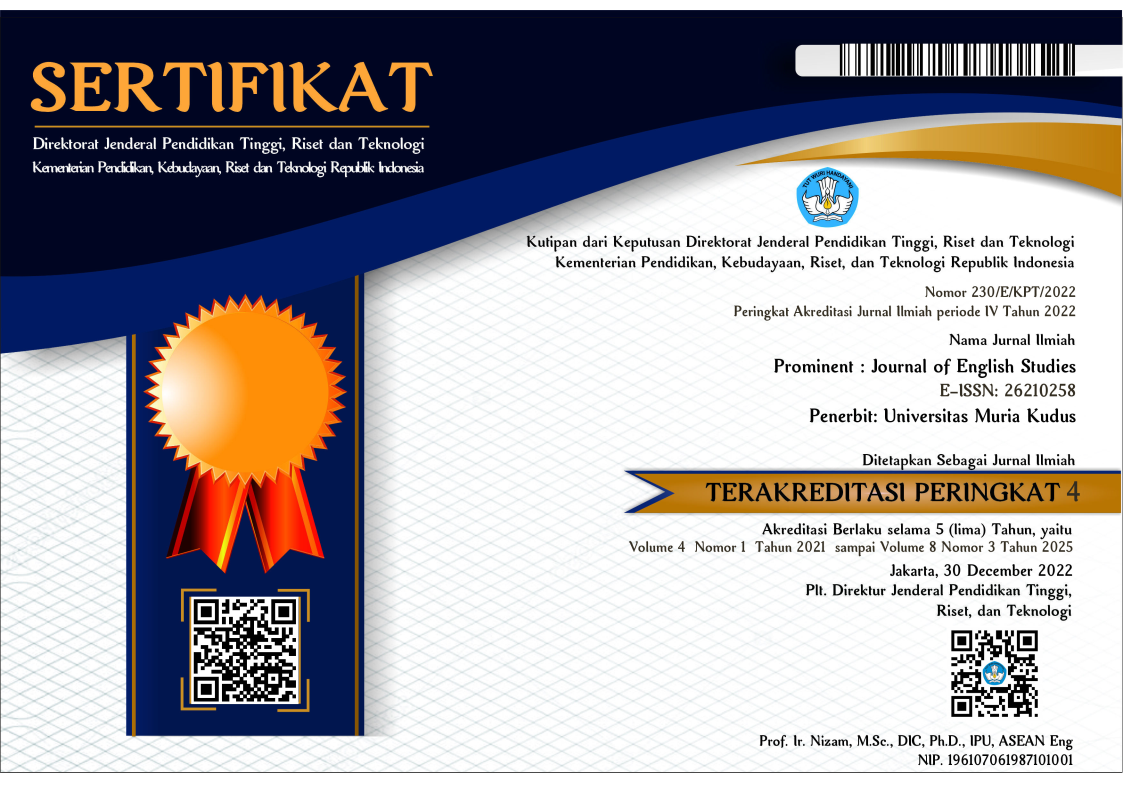- Home
- Vol 1, No 1 (2018)
- Madjdi
DOES THE WRITER OF ENGLISH TEXTBOOK INTEGRATE NORMS IN READING PASSAGES HE/SHE WROTE?
Achmad Hilal Madjdi
Atik Rokhayani
Abstract
A serious challenge which is faced by teachers is educating character and bringing norms being practiced by the society into the classrooom, and English teacher is no exception. The challenge makes IndonesianEducation is very dynamic as everything dealing with normsis always thethe concern and developed by scholars, parents as well as the government. Some scholars propose to foster English teachers as models of practicing norms, while some others think to integrate norms into teaching materials. The second thought invites curriousity on how the writer of English textbook supports the recent concern on norms, and the research on it becomes very important to do. Therefore the research dealing with several reading passages in the English Textbook was done. The design was descriptive qualitative which aimed at investigating whether the writer of English textbook integrates norms in reading passages he/ she wrote. The data was norms, while the data sources were reading passages in the 2015-English Textbook developed by The Ministry of Education and Culture. The result describes that norms of trust, discipline, respect to others and self-confidence were found in reading passages. It can be then concluded that the writer of English textbook integratesnorms in the text he/ she writes. The results of the research implies not only the seriousness of scholars, parents and government in fostering character education, but also the support and care of textbook writer in succeeding the education.It is therefore suggested to teachers, scholars as well as book writer to always concern with the society’s need in developing education, especially in sharing the existed and practiced norms.
References
Damon, William. 2002. Bringing in a New Era in Character Education. California: Hoover Institute Press.
Fairclough, N. 1992. Language and Power. Longman
Fauziati, Endang. 2010. Teaching English as a Foreign Language (TEFL). Surakarta: PT Era Pustaka.
Garinger, D. (2002). Textbook Selectiom for the ESL Classroom. Eric Clearinghouse on Languages and Linguistics.
.
Harmer, Jeremy. 2007. The Practice of English Language Teaching. Pearson-
Longman.
Hughes, R. (2002). “Teaching and Researching Speaking”. Harlow: Pearson Education Limited.
KementrianPendidikandanKebudayaan. (2014). English Textbook. Jakarta: KementrianPendidikandanKebudayaan.
Kertajaya, H. 2011. Grow with Character. Gramedia.
Mcelmeel, S., L. 2002. Character Education. A Book Guide for Teachers, Librarians and Parents. Colorado: A division of Publishing Group. Inc.
Nucci. Larry P. 2001. Education in the Moral Domain. Cambridge: Cambridge University Press
Pines, Susan. 2006. Young Person’s Character Education Handbook. Jist Publishing Inc.
Tarigan, Henry G and TariganDjago.1986. Telaah Buku Teks Bahasa Indonesia. Bandung: PT. Angkara.http://en.m.wikipedia.org/wiki/Wikipedia: ManualofStyle/Captions.
Wu, Vivian Wen-Chi, and Pen- hsiang Natalie Wu. 2008. Creating and Authentic
EFL Learning Environment to Enhance Student Motivation to Study English.
Asean EFL Journal Volume 10. Issue 4 Article 11. (http://www.asian-efl-
journal.com/December_08_wcw.php, accessed July 7, 2010).
DOI:
https://doi.org/10.24176/pro.v1i1.2503
Article Metrics

Abstract views :
281|

PDF views :
299

Refbacks
- There are currently no refbacks.





